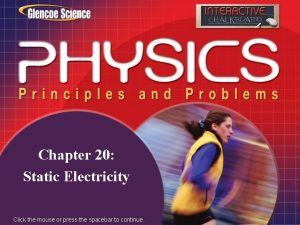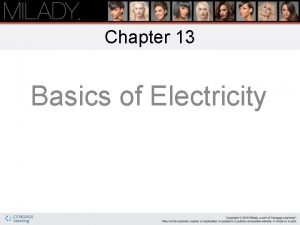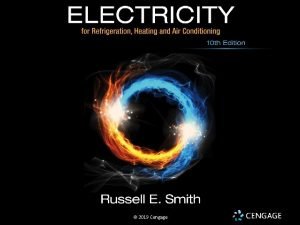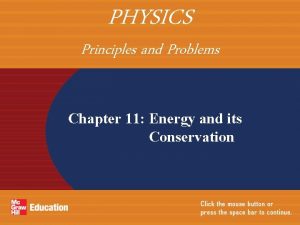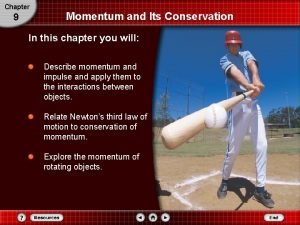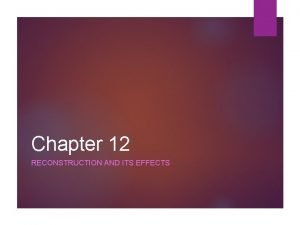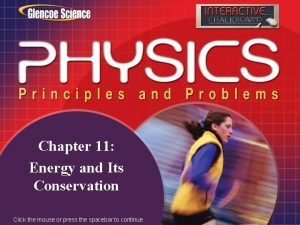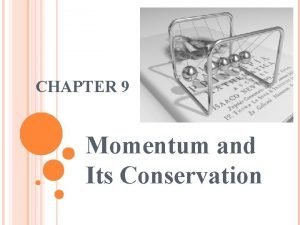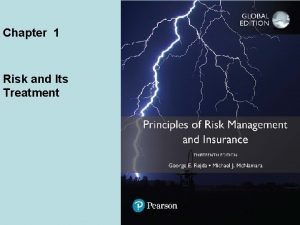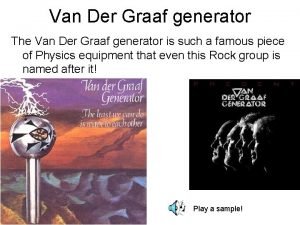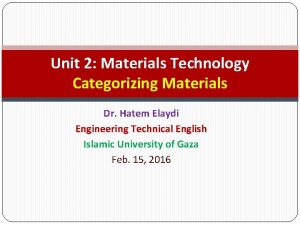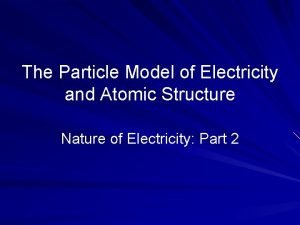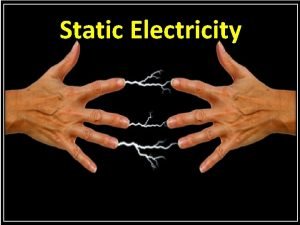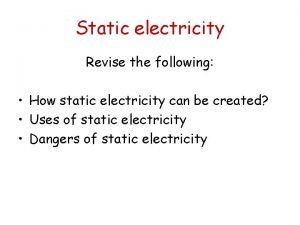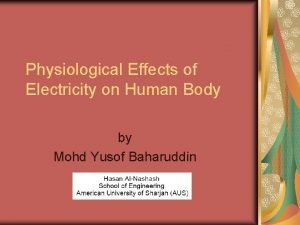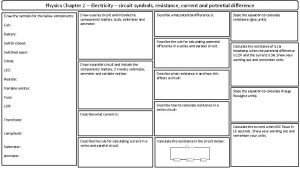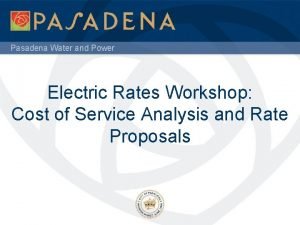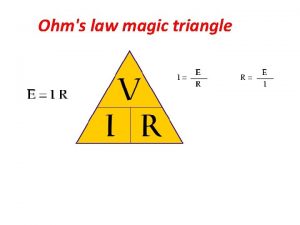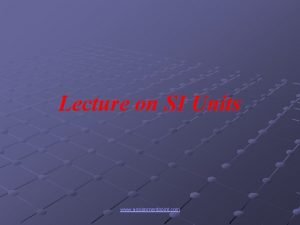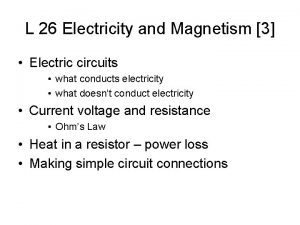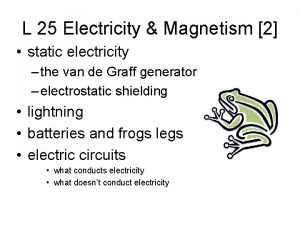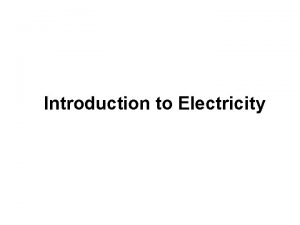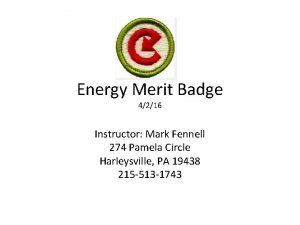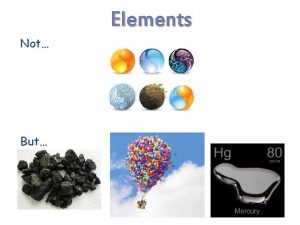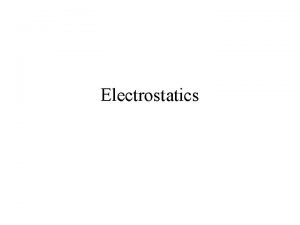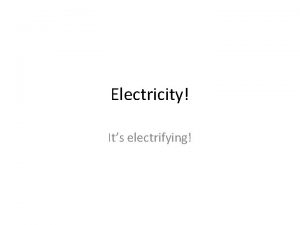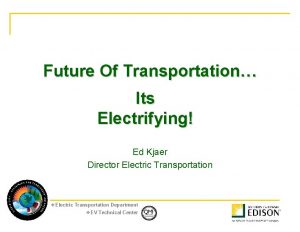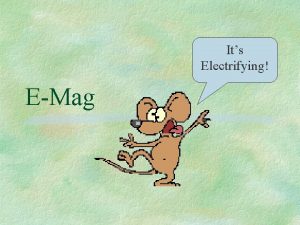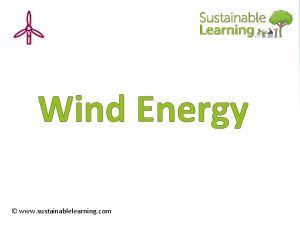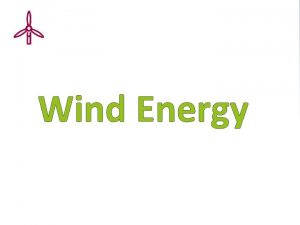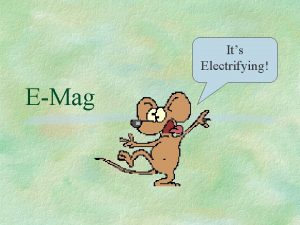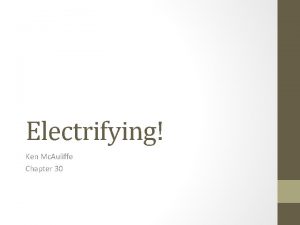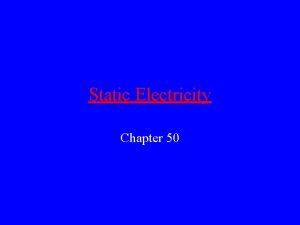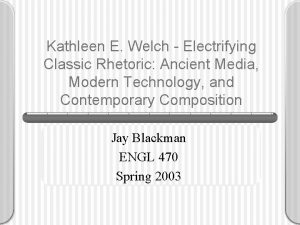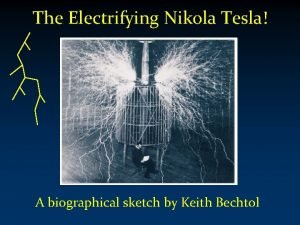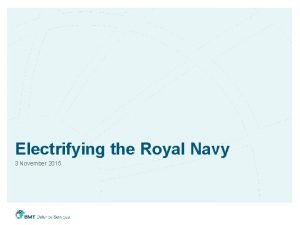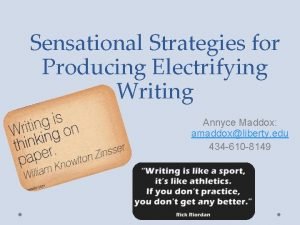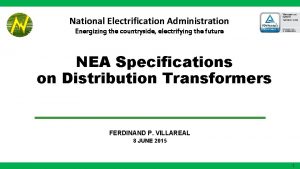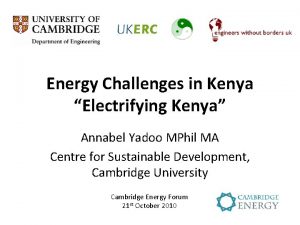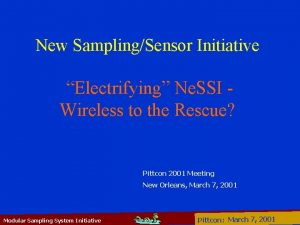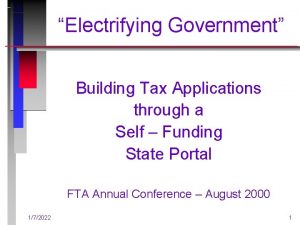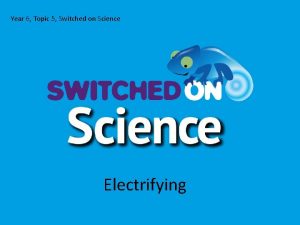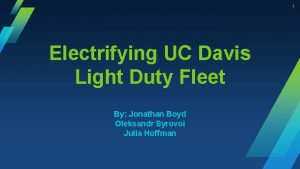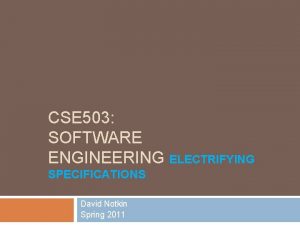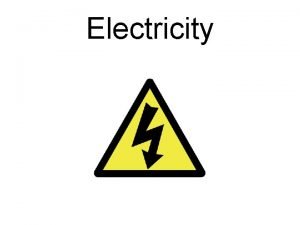Electricity Its electrifying Chapter 5 What is Electricity






















































- Slides: 54

Electricity It’s electrifying! Chapter 5

What is Electricity? • Definition: it is the phenomena caused by positive and negative charges. • There are two types of electricity: – Static electricity → deals with the imbalance of electrical charges at rest within or on the surface of materials. – Dynamic electricity → deals with the motion of negative charges carried by electrons through an electrical circuit.

Before we discuss Static and Dynamic… • Atom Review! –The atom is composed of three fundamental particles • Protons which carry a positive charge • Electrons which carry a negative charge • Neutrons which carry no charge –In electricity, we care about protons and electrons due to their charges. –It’s the electrons that can leave the atom. (this is important!)

Charges, charges • A positively charged body is something that has fewer electrons than protons, so it has an overall positive net charge • A negatively charged body is something that has more electrons than protons, so it has an overall negative net charge • A proton and electron has a elementary charge of 1. 602 x 10 -19 C – A proton would be + 1. 602 x 10 -19 C – An electron would be - 1. 602 x 10 -19 C

Static Electricity • Deals with the electrical phenomena with non-moving charges, where electrically charged object have an imbalance of charges. • This imbalance can be an imbalance of positive charges or an imbalance of negative charges • The key thing with static electricity, is that charged objects don’t stay permanently charged! • Objects can lose the charge very quickly, or gradually.

Static Electricity - Losing Charge • There are two ways charged objects lose there charge. – Naturally (i. e. nothing prompted it to loose it, just wore off) – Electrostatic discharge → a negatively charged object touches/comes in close contact with a positively charged object • When you “shock” someone, this is what is happening! Electrons from the negatively charged object pass through the air to the positively charged object, causing both objects to have a net neutral charge. • When the objects lose their charge, they are “neutral”

Static Electricity - Charging an Object • There are three ways to charge an object – Friction → rubbing two neutral objects together. When doing so, electrons from one transfer to the other. One object becomes negatively charged, and the other is positively charged. – Conduction → putting a neutral object in direct contact with a charged object. The two objects then share the charge between them. – Induction → putting a charged object near a neutral object without physically touching it.

Friction • Rubbing of two neutral bodies together. – The atoms in one of the objects will pull electrons away from the other. – As a result, you will have one body that will become negatively charged (one that take electrons) and another which will become positively charged. • Which object will become positively and negatively charged depends on the materials that the object is made of.

Friction tendency chart Tendency Substance High affinity to capture • Plastic electrons, (take on negative • Sulphur charge). • Gold • Nickel, copper • Hard rubber • Wood, yellow amber, resin • Cotton • Paper Strong tendency to give • Silk electrons, (take on positive • Lead charge). • Wool • Glass

Friction • Plastic rod rubbed with wool: – Plastic pulls some electrons from wool, so plastic becomes negative and wool become positive. • Glass rod rubbed with wool: – Wool pulls some electrons from glass, so wool becomes negative and glass becomes positive. • Plastic rod rubbed with silk: – Plastic pulls some electrons from silk, so plastic becomes negative and silk becomes positive. • Glass rod rubbed with silk: – Silk pulls some electrons from glass, so silk becomes negative and glass becomes positive. • Key: The charge of each material depends on what has a higher tendency to give up electrons.

Friction

Conduction • Physical touch of one charged body with a neutral body. • The charges from the charged body flow to the neutral body, thus sharing the charges between them. • As a result, there are two objects with the same charge.

Conduction

Induction • Charging a neutral body without physically touching it! • When you bring a charged object towards a neutral object, the opposite charges of your charged object will begin to accumulate (remember, opposites attract ). • Example: Bringing a negatively charged comb towards neutral pieces of tissue paper. Positive charges will build up on the side of the tissue paper closest to the comb, and negative charges will build up on the other side.

Induction

Method Friction Before Two neutral objects During After Friction pulls electrons Two objects with opposite away from one of the charges. objects and transfers them to the other. + - Conduction One charged object and The charge of one neutral object is shared between two objects when they come into -contact. Two objects with a like charge. Induction One charged object and one object carrying a partial positive charge on one side and a partial negative charge on the other side. One charged object and The proximity of the one neutral object. charged object causes the charges in the neutral object to +separate. + +- - + - +

Attraction and Repulsion between charged bodies • Just like in magnetism, statically charged bodies have attractive and repulsive forces between each other. • Like charges repel each other. • Opposite charges attract each other.

Attraction between two statically charged bodies + -

Repulsion between two statically charged bodies + + - -

Dynamic Electricity Definition: electricity caused by the flow of electric charges • So, dynamic electricity is the electricity you get in wires. (Powering everything you can think of: cell phones, computers, etc. )

Conductors vs. Insulators • Conductors: Substances that allow electricity to flow through them easily. • These substances contain free electrons (electrons that are weakly attracted to nucleus) that move from atom to atom → generating electricity. • In other words, electricity is easily transferred in a conductor. • Insulators: Substances that do not allow electricity to flow through them easily. • Insulators impede the flow of electricity. • When an insulator is charged, the charge does not run freely throughout it.

Conductors and Insulators Substance Air Rubber Copper Aluminum Porcelain Glass Wood Iron Conductor Insulator ☺ ☺ ☺ ☺

Current Intensity Definition: The rate of the flow of electrons through a medium. • In other words, the number of electrons in a circuit going by a particular point every second. • Intensity is symbolized with the letter I and measured in amperes, (amps). • How fast the electrons are moving, (speed). • Unit: Amperes (A) • A circuit with a current intensity of 9 A has electrons moving faster than a circuit with a current intensity of 4 A. • An ammeter is an instrument for measuring current intensity. It acts like a checkpoint in a circuit, counting the number of charges that pass in a second.

4 Factors Affecting Conductance (current intensity) 1. Thickness of a conductor, (diameter of wire). – 2. Length of the conductor. – 3. The longer the wire, the lower the conductance. Type/what material wire is made from. – 4. The thicker the wire, the higher the conductance. Best in order of conductance: Silver, Copper, Aluminum, Bronze and Steel Temperature. – The higher the temperature, the lower the conductance. Fat, short, silver and cold! → Best combo for conductance

Potential Difference Definition: The amount of energy transferred between two points in an electrical circuit. • It’s the work needed to move a charge (electron) from point A to point B in a circuit • It’s the “energy” the electrons have, or how quickly they move. • The greater the potential difference, between two points, the larger the amount of energy transferred. • Unit: Voltage (V)

• Attach the voltmeter on either side of an element in an electrical circuit.

Resistance • Definition: The ability of a material to hinder or slow the flow of electric current. • How much something is slowing down the speed of electrons • A force that slows down the flow of current • Occurs when electrical energy is being transferred into another type of energy, (heat, sound, thermal, etc) • Think of a hurdle race; the hurdles slow down the speed of the runners so that they aren’t running at their top speed • Unit: Ohms (Ω) • R= V/I (resistance = volts/intensity) • Is the exact opposite of conductance!

… • Examples of resistors: toasters, ceiling fan, lights • When a resistor is in a circuit, there is a drop in the amount of energy being transferred – that energy is needed to power the lightbulb, the toaster filament, etc. • You can improve a resistor by: • Changing material, lengthening, reducing diameter, increasing heat. • So, the opposite characteristics of conductance.

Ohm’s Law A Very Important Rule V=Ix. R R = V/ I I = V/ R Where V= potential difference (in V) I= current intensity (in A) R= resistance (in Ω)

Ohm’s Law triangle

Recall on how to read a the triangles • You cover the letter that you are trying to solve. • The position of where the remaining letters is the equation • If you are solving for potential difference, you cover the V. I and R are both on the same level, so you multiply them • If you are solving for resistance, you cover the R. V is on top of I, so you divide V by I

Convert m. A to A (Divide by 1000) 50 m. A/1000 = 0. 05 A



Current (I) 1 A 2 A 3 A 4 A Potential Difference (V) 2 V 4 V 6 V 8 V Resistance Graph 9 Potential Difference 8 7 6 5 4 3 2 1 0 0 0. 5 1 1. 5 2 2. 5 Current Intensity 3 3. 5 4 4. 5

Circuit Diagrams • An electric circuit is a path for the flow of electricity. • Made up of: • • • Power supply: provides the electric current (I) Connecting wires Elements: provides resistance Fuses/breakers: provides protection Switches: provides control (to turn on/off system) Instruments using and/or measuring electricity

Circuit Diagram symbols Power Supply Fuse

Series Circuit

Parallel Circuit

Series vs Parallel Series • Components are connected end to end. • Currents flows in only one path. • One defective component stops the charges from flowing. • More resistance = less current = less power = less energy

Series vs Parallel • Contains at least one branch and contains nodes. • Place where current splits to different paths and merges back. • Defective components only affect current flow on the pathway it is on, not the entire circuit • Resistance is shared by all paths • Less resistance = more current = more power = more energy

How to measure Potential Difference and Current Intensity • Potential difference and current intensity machines are attached to your circuit. – An ammeter measures current intensity, (in AMPS) – An voltmeter measures potential difference, (in VOLTS) Unit: A (ampere) Unit: V (volts)

How to connect these things! • An ammeter needs to be connected in series. • Meaning it is on the main line.

How to connect these things! • An voltmeter needs to be connected in parallel. • Meaning it is on its own circuit.

Power Definition: The amount of work an electrical device can perform per unit time. • The more powerful the device, the faster it works! • Unit : Watts (W)* P=Vx. I – formula for calculating power. P= Power (W) V=Potential Difference (V) I= Current Intensity (I)

Power Triangle

Energy • Simply, energy is power multiplied by the period of time. – i. e. the energy that your i. Pod consumes is the power multiplied by how long it’s on E=PΔt • There are three possible units for energy: – Joules (J) – Kilowatt hours (k. Wh) – Watt hours (Wh)

Energy • If your energy is in joules (J), your power must be in watts (W) and your time in seconds (s). • If your energy is in kilowatt hours (k. Wh), your power must be in kilowatts (KW) and your time in hours (h). • If your energy is in watt hours (Wh), your power must be in watts (W) and your time in hours (h). NOTE!!!! 1 KW is 1000 W. 1 hour is 3600 seconds.

Multiply by 3600 (60*60) Multiply by 60 Hours Multiply by 60 Minutes Divide by 60 Seconds Divide by 60 Divide by 3600 (60*60)

Multiply by 1000 Kilowatts Watts Divide by 1000

Multiply by 1000 Kilojoules Joules Divide by 1000

Multiply by 1000 (to convert KW to W) then multiply by 3600 (to convert h to s) Kilowatt hours Joules Divide by 1000 (to convert W to KW) then divide by 3600 (to convert s to h)


X 1000 Kilo X 1000 Unit / 1000 Milli / 1000
 Static electricity and current electricity
Static electricity and current electricity Static electricity and current electricity
Static electricity and current electricity How are static electricity and current electricity alike
How are static electricity and current electricity alike The emigree poem
The emigree poem When a train increases its velocity, its momentum
When a train increases its velocity, its momentum Windy cloudy rainy sunny
Windy cloudy rainy sunny If its square its a sonnet
If its square its a sonnet Its halloween its halloween the moon is full and bright
Its halloween its halloween the moon is full and bright Its not easy but its worth it
Its not easy but its worth it Chapter 6 electricity section 1 electric charge answers
Chapter 6 electricity section 1 electric charge answers Chapter 20 static electricity answers
Chapter 20 static electricity answers Anaphoresis and cataphoresis
Anaphoresis and cataphoresis Chapter 12 basic electricity
Chapter 12 basic electricity Chapter 2 basic electricity
Chapter 2 basic electricity Chapter 22 section 5 the end of the war and its legacy
Chapter 22 section 5 the end of the war and its legacy Chapter 11 study guide physics
Chapter 11 study guide physics A 1875 kg car going 23 m/s
A 1875 kg car going 23 m/s Chapter 12 section 1 the politics of reconstruction
Chapter 12 section 1 the politics of reconstruction Chapter 11 energy and its conservation answers
Chapter 11 energy and its conservation answers Total momentum formula
Total momentum formula Which is represented by the equation fδt = pf - pi ?
Which is represented by the equation fδt = pf - pi ? Chapter 17 manifest destiny and its legacy
Chapter 17 manifest destiny and its legacy Chapter 1 risk and its treatment
Chapter 1 risk and its treatment Chapter 5 elasticity and its application multiple choice
Chapter 5 elasticity and its application multiple choice Chapter 12 reconstruction and its effects
Chapter 12 reconstruction and its effects Chapter 3 section 1 england and its colonies
Chapter 3 section 1 england and its colonies 4 forces of nature
4 forces of nature Van der graaf generator fysica
Van der graaf generator fysica Unit 2 materials technology
Unit 2 materials technology Ib physics electricity and magnetism
Ib physics electricity and magnetism Weather merit badge requirements
Weather merit badge requirements Pros cons fracking
Pros cons fracking Particle model of electricity
Particle model of electricity Electricity flow
Electricity flow Static electricity photocopier
Static electricity photocopier Snc1d electricity
Snc1d electricity Substance
Substance Physiological effects of electricity on the human body
Physiological effects of electricity on the human body Physics symbols electricity
Physics symbols electricity Electricity and magnetism lecture notes
Electricity and magnetism lecture notes Pasadena water and power
Pasadena water and power Ohm's law triangle
Ohm's law triangle What is the nature of electricity
What is the nature of electricity Tariff system grade 12
Tariff system grade 12 Kg.s-1
Kg.s-1 Physics 241
Physics 241 Water conducts electricity
Water conducts electricity Salt water electricity generator
Salt water electricity generator What is the symbol of coulomb
What is the symbol of coulomb Energy merit badge answers
Energy merit badge answers Energy slogan
Energy slogan Elements that are shiny and conduct heat are called ______.
Elements that are shiny and conduct heat are called ______. Electricity is all around us
Electricity is all around us Bill nye electricity worksheet
Bill nye electricity worksheet History of electricity
History of electricity










